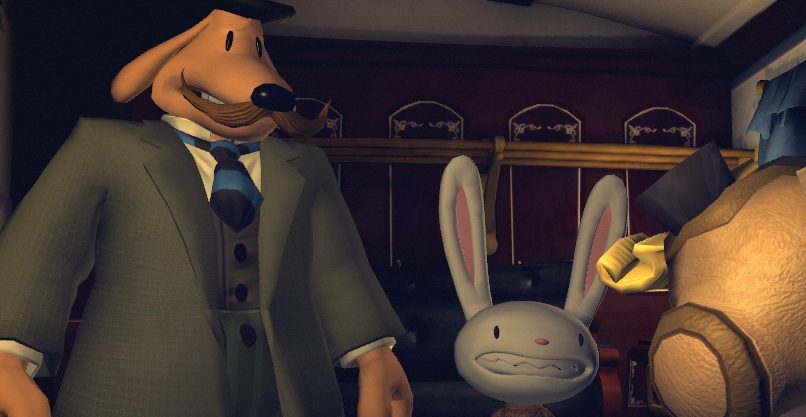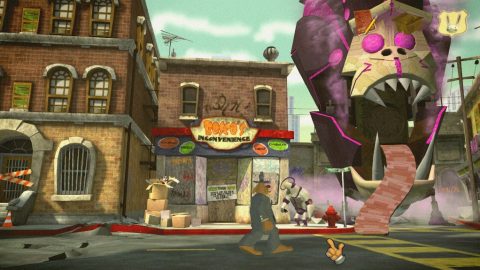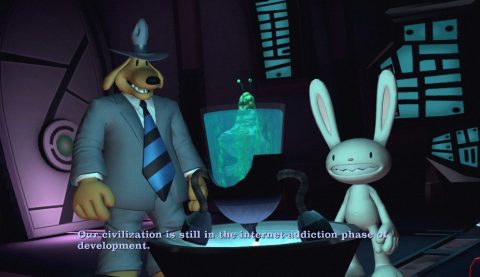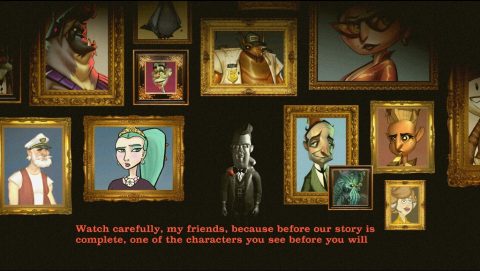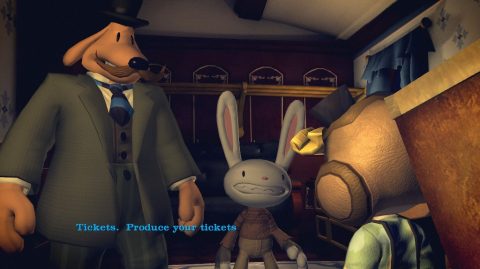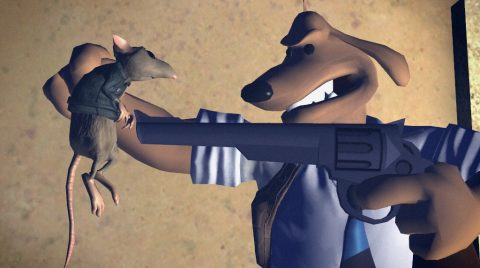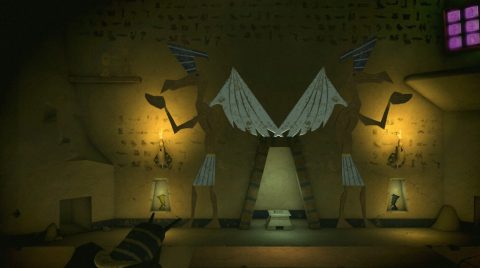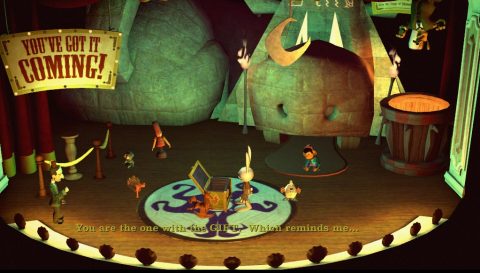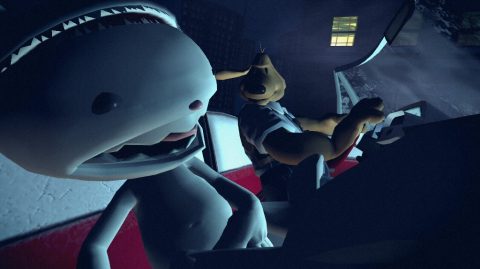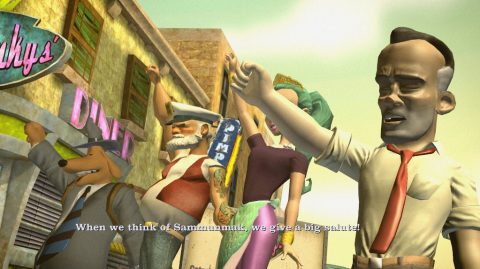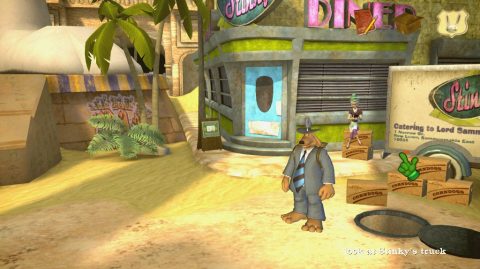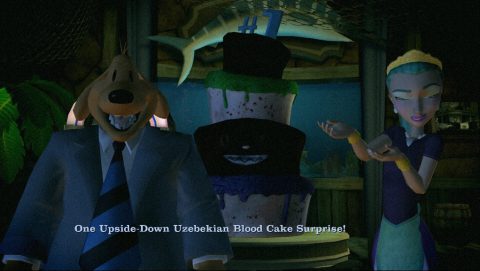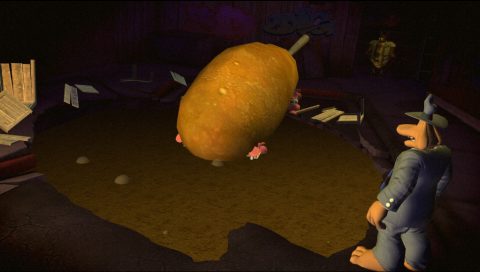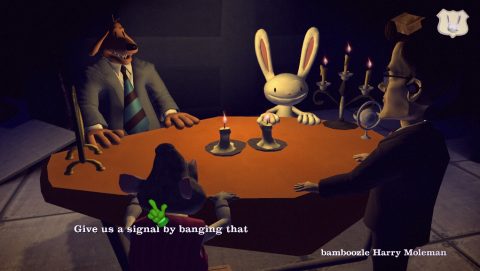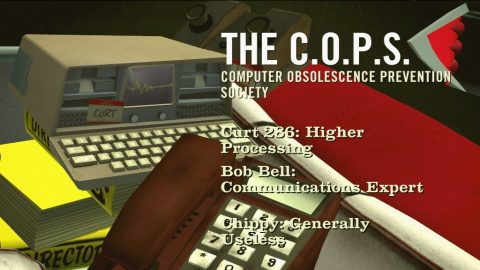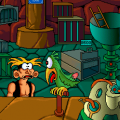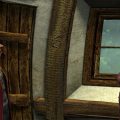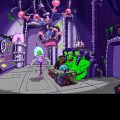- Sam & Max Hit the Road
- Sam and Max Save the World (Season 1)
- Sam and Max Beyond Time and Space (Season 2)
- Sam and Max: The Devil’s Playhouse (Season 3)
The Devil’s Playhouse marks a further evolution for the Telltale Sam & Max seasons. Although still consisting of five episodes, they tell a continuous story rather than dealing with unrelated incidents connected only by vague recurring themes. This time it revolves around a legendary artifact called The Devil’s Toybox, which is sought by various entities for a number of reasons. Of course due to the episodic nature, the story runs off on various tangents as they concentrate on the villains and their plans in each episode, but it’s also far more cohesive than either previous season. Each episode also ends with a cliffhanger which leads directly into the next.
There’s also far less repetition, as the routine has been broken quite a bit. While the exterior of Sam and Max’s office still plays a recurring role in the story, it’s no longer the hub of each episode, and the scenery is usually entirely different from case to case. You no longer need to visit Sybil or Bosco or the COPS every episode – in fact, these characters only play small roles in the story, if they even appear at all. (Bosco is completely absent.) Instead of just spoofing various movie titles, it parodies various motion picture genres. One plays with old-time adventure flicks. Another takes a page from detective noir. Homages are also made to zombie and kaiju films. Some characters are still re-used, but it’s less much inappropriate than some of Telltale’s other games.
In addition to the change in structure, the third season brings about some enhancements to the engine. The visuals have been improved, although not substantially, and are set to widescreen regardless of your monitor size. The interface has been changed to the one found in Tales of Monkey Island, where you control Sam using the keyboard and use the mouse cursor to interact with stuff. The dialogue system has been yanked from Mass Effect, with a radial menu that features various topics, rather than explicit lines of dialogue. Many of these seem to exist to make it more playable on a console, although it functions well enough on the computer.
Max also has newfound access to a variety of psychic powers. “Future Vision” lets you peek a few moments forward in time. It is not merely a hint function, because most of the time, its usage is mandatory to figure out what you’re supposed to be doing. In one early example, if you use Future Vision on Flint, you’ll see him get murdered by an axe. Just give him a helmet to protect him, and you’re set. Obviously, this puzzle makes no sense unless you’ve used this skill. “Ventriloquism” allows you to project your voice into different characters or objects. Not technically a psychic power, Sam remarks, but a useful skill nonetheless. “Teleportation” lets you visit any location with a phone, as long as you have its number. It’s mostly used to speed transitions between locations, although there are a few puzzles involving it as well. “Mind Reading” is obvious enough. “Rhinoplasty” gives you a piece of silly putty, which you can use to copy an item and make Max transform into it
So many of the puzzles (and extra gags) are focused on the psychic powers that they become the crux of the gameplay. Most of their usage is remarkably clever, since many of them provide clues without solving the puzzle outright, and it’s up to the player to interpret them. For all of its ingenuity, though, certain puzzles are a bit overused, especially when it comes to the Rhinoplasty skill. The specific powers vary from episode to episode, gaining some and losing some as appropriate.
Each chapter is introduced by the Narrator, who explains the scenario much like Rod Serling from The Twilight Zone, with a pinch of Bela Lugosi’s “god” character from various Ed Wood movies. His scenes are entirely in black and white, except for the red rose on his lapel. They’re gloriously cheesy and melodramatic, and the way this frame story ties into the main plot is one of the most brilliant moments of the Telltale seasons.
The first chapter, The Penal Zone (Based on the classic instructional video “How to Use Your New SM-301 Industrial Strength Dehumidifier”), introduces the world to Skun-ka’pe. (It’s pronounced “skun-KAH-pay”, although the heroes just call him “Skunkape”.) He’s a space gorilla who happens to be a toy collector. His goal? To find the Devil’s Toybox, a mysterious artifact filled with items which hold various psychic powers. Of course, Max gets a hold of them instead, which is the cause for hijinx. In an interesting twist, the introduction to the chapter finds Sam and Max captured by Skun-ka’pe, but this is merely a vision of the future told by Max’s powers. Once returned to the present, the heroes are already well aware of the threats presented to them, and try to avoid them. Naturally, things don’t quite work out as planned.
Compared to some of the other chapters, The Penal Zone is relatively restrained, at least as restrained as one can get when combating tyrannical intergalactic apes. Most of the chapter involves driving around the city and figuring out the various mechanisms of Skun-ka’pe’s spaceship. The eventual goal is to damn the villain to the Penal Zone, an alternate dimension used to punish and contain intergalactic threats. This naturally leads to some juvenile but reasonably funny jokes. (“Not only did I defeat Sam & Max, but I took care of the Penal Zone in one stroke!” Skun-ka’pe proclaims, much to Max’s bemusement.)
The Tomb of Sammun-Mak (Based on the scandalous 19th Century zoetrope “The Lady Visits Her Chiropractor”) takes place after banishing Skun-ka’pe to the Penal Zone. Sam and Max discover a pair of skeletons in the basement of their office building. They look suspiciously like the duo, with Sam grappling Max’s neck. Clearly disturbed, they find a projector with four film reels, which recount the exploits of their great-grandfathers, Sameth and Maximus. This old-timey partnership look and act much like their descendents, except Sameth has a mustache and Maximus actually wears clothes. Together, they must uncover the Riddle of the Sphunx, a cheesy stageshow led by the suspicious Monsieur Paperwaite. This eventually leads them to the Tomb of the Sammun-Mak in Egypt, where they need to steal the Devil’s Toybox and make it sure it arrives safely back home in New York.
In the meantime, they need to deal with the mole people, who are positioned as a mish-mash of various ethnic groups. They are the guardians of the tombs, technically making them Egyptians, but their accents make them sound like Eastern-Europeans. They also have the power to inflict curses, which is actually mandatory for certain puzzles. Many characters from prior games have been reused, which feels a little bit lazy. Santa Claus reappears as Mr. Kringle, the maleficent toy mogul, although interacting with his goofy legion of elves is amusing, as you get to visit their ghetto in “New Arctic Circle”. Also appearing is Baby Amelia Earhart from Moai Better Blues, for no real reason, and Jurgen, back in his pre-vampire days.
This episode uses a unique gimmick, in that the storyline is not entirely linear. Each “act” is encapsulated on one of the four reels, and you actually begin in the middle of the third one. However, you need to change reels in order to get necessary information from previous parts of the plot. For example, when trying to escape from the tomb, Sameth and Maximus need to decode some hieroglyphics. They don’t know how to do this, but upon transporting back to an earlier reel, they can question one of the mole people for the answer. Naturally, the fourth reel is the epilogue, and can only be properly completed once you’ve finished the first three. Not only it is remarkably innovative, but it’s also the first real time you can actually “die” in a Sam & Max game. If you screw up, though, Sam and Max simply rewind the film in the present day, allowing you to immediately redo your actions.
The third episode is entitled They Stole Max’s Brain! (Based on the similarly-titled novel by Jane Austen). During the finale of the Sammun-Mak film, Sam sneaks off to take a bathroom break. He returns to find Max’s lifeless body, with his head unzipped and his brain stolen. Going completely unhinged, Sam goes on a rampage around town, browbeating various witnesses to figure out the location of the perpetrators. This film noir parody takes the form of an elaborate dialogue puzzle, where Sam can threaten or accuse the questionees at various points in their monologues, getting them to spill more information. These truths can then be used to call out other witnesses, as you slowly piece together the truth. (It’s also somewhat similar to the courtroom scenes in Capcom’s Ace Attorney scenes.) During these interrogations, there’s also an option labeled “Noir”, which will prompt Sam to meander off into a darkly cheesy metaphor. This section is awesome, if only to see the normally straight-laced Sam charge on an anger-fueled frenzy, verbally pummeling the poor schmucks that get in his way.
The trail eventually leads to the Museum of Almost Natural History, where Skun-ka’pe, who has escaped from the Penal Zone, and Paperwaite, who is now immortal, are fighting over possession of the Devil’s Toybox, using Max’s psychic brain to unlock its secrets. However, they briefly ally their powers against Sam, their common enemy. At this point, Sam discovers the preserved brain of an ancient pharaoh – Sammun-Mak, of course – and uses it to reanimate Max’s body. They manage to overtake Skun-ka’pe and Paperwaite, only for Sammun-Mak to take control of the toybox and use it to enslave the city through his brainwashing powers. The only one unaffected is Max, still separated from his body and merely a brain in a jar strapped to Sam’s back. It’s up to their strained partnership to connect with the underground resistance, knock everyone back into their senses, and take down the deluded psychic pharaoh. This episode also introduces two new characters – Sal, a rather genial giant cockroach who sounds a lot like Patrick Warburton, and Hubert Q. Tourist, a perpetually confused European (you guessed it) tourist which a penchant for peppering his speech with German-sounding gibberish.
They Stole Max’s Brain! has been criticized by gamers for playing too much with the dynamic between the heroes. Max is completely missing from the first act, while Sammun-Mak takes his place in the second. They share some commonalities, mostly in their delight for violence, but something doesn’t feel right, and Sam is clearly disturbed. And in the third act, Max isn’t fully able to interact with Sam, due to his zombified status. While it removes some of the familiarity, in the end it actually works to strengthen the bond between the two. It shows how much the duo depends on each other, as both are clearly ill at ease without the other’s presence.
In Beyond the Alley of the Dolls (Loosely based on the forbidden scrimshaw carvings of Bob Keeshan), the city is overrun by an army of Sam clones, all clad in only their undies. Shacked up in Stinky’s Diner and attempting to defend themselves a la any number of zombie flicks, the duo find a secret lab underground with hundreds of cloned Sams. The conspiracy takes further twists, culminating in a battle on the Statue of Liberty. This episode introduces Yog-Soggoth, a Cthulhu-like entity from a different dimension. While he once sought to become the lord of humanity, he’s cooled off a bit since then, and is more than content to simply find his way home. He’s also in a weakened state, as he only exists as a tumor in the chest of one of the other characters. Yog-Soggoth aids in your quest to avert the resurrection of his son, Junior, whose attitude towards humanity may not be as pleasant as his own.
In the final chapter, The City That Never Sleeps (Based on the Cherished ‘80s Adult Film, “Totally Into Max”), Junior’s seed has accidentally been fused with Max, turning him into a gigantic Lovecraftian monster and unleashing a Godzilla-like spree across New York City. He feeds off the dreams of the populace, so none of them can fall asleep, hence the title. This episode sees the return of characters who were missing from previous episodes, including Sybil (now very pregnant with Abraham Lincoln’s child) and Mr. Featherly, although Bosco is still absent. The cast gets together to formulate a plan to get inside Max’s gigantic belly, which involves turning the DeSoto into an enormous corndog.
Max’s interior is far from the typical biological setting, as each of his major organs has been redone to look like the interior of a ‘70s household. You need to gain control of his motor functions in order to access his brain and put a stop to everything, but all of the psychic powers that you’ve used previously are now being used against you. Indeed, this is another odd chapter, since Max technically isn’t part of your gang. Little flaming apparitions of him float around and provide similar commentary, but the psychic powers are no longer as your disposal, and the puzzles are relegated to the standard inventory and dialogue types.
This chapter feels tacked on, because the main storyline involving the Devil’s Toybox is finished up at the end of the fourth episode. Instead, it feels like more of an epilogue to use returning characters and finish the arcs of the existing ones. It’s also hard to hold much against it, because it’s an excellent chapter. There are a lot of great jokes, especially the storeroom, which holds memories from both the previous Telltale games and the LucasArts adventure. And some of the best sight gags in Sam & Max comes from the satirical signs and products – this one has a box of “Oops, Diabetes!” breakfast cereal. Max also has a library of story ideas, which is represented as a series of records. In addition to the one needed to solve a puzzle, there are also a few really goofy ones, like the Flint Paper fan fiction and a historical thriller involving Eli Whitney, inventor of the cotton gin.
The finale also explains the title, which has nothing to do with the devil Satan (although he does make an appearance). It’s a reference to an old saying, with a bit of a twist – if idle hands are the devil’s play thing, then an idle mind is the devil’s playhouse. The ending is also surprisingly heartfelt. Like Tales of Monkey Island, Telltale introduces a significant amount of drama to the story, adding quite a bit of depth to a series which has rarely been more than an incredibly silly cartoon.
While the tone is ultimately far, far removed from the sardonic, happy-go-lucky shenanigans of the original LucasArts games, The Devil’s Playhouse is an incredibly well-written, well-crafted series of adventures, and easily one of Telltale’s best.
The Comics
Most of Sam and Max’s original adventures are contained in the anthology Sam & Max Surfin’ the Highway. This includes several chapters of the original comic, as well as some of the works Steve Purcell created for The Adventurer, the LucasArts catalog. These often put Sam & Max in the role of various other Lucasfilm properties, with amusing results.
Sam and Max: Freelance Police – The Animated Cartoon
Sam & Max also found themselves subject of a cartoon series, produced by Canadian studio Nelvana. Airing in 1997 on Fox networks, the season includes a total of thirteen episodes, most consisting of two ten-minute stories. Steve Purcell was actively involved in the project, and even scripted a few episodes.
Of course, Sam & Max were originally meant for adults, and some of the duo’s antics have been toned down to make it suitable for children’s programming. Max isn’t sociopathic anymore so much as lovably weird, and Sam loses some of his dry edginess in favor of flat-out goofiness. Most of their pseudo-eloquent vocabulary was also toned down to understandable levels. Their handguns have been ditched for being too realistic, but they’ve been allowed to keep some of the crazier weapons, like rocket launchers and flamethrowers. Perhaps to make the program more relatable, there’s also a new character known as The Geek, an incredibly intelligent young girl who works as Sam & Max’s inventor. Thankfully, her presence is minimal. Unfortunately, the voice actors from Hit the Road were unable to reprise their roles, and the new guys, while tolerable, sound a little bit too wacky.
While it’s substantially bowdlerized compared to its original incarnations, it still captures much of its madcap insanity. One of the earlier episodes is based on a comic story, “Bad Day on the Moon”, where they launch their DeSoto into space to take on a roach menace. In other episodes, Sam & Max are stalked by the fanboy Lorne, their self-appointed “Friend for Life”, who even gets his own stupid little jingle. They also meet up with Granny Ruth, Sam’s take-no-guff grandmother who also runs a maximum security prison. The team occasionally faces off against various super villains, including Mack Salmon, a criminal with a fishbowl for a head (who was also briefly in the comics), and they even get entangled in the marital woes of Zeus and Hera. Other aspects remain faithful to the comics, include the preoccupation with rats, sasquatches, and molemen. And similar to Warner Bros. cartoons like Animaniacs, there are plenty of movie parodies that only adults would fully understand, and both Sam & Max are quite cognizant of the fourth wall.
While Sam & Max: Freelance Police probably would’ve worked better as a primetime cartoon (or at least something on Adult Swim, although that didn’t exist back in 1997), as a cartoon aimed for kids, it’s pretty decent. The entire series was released on DVD in 2008 to capitalize on the popularity of the Telltale Sam & Max games.
